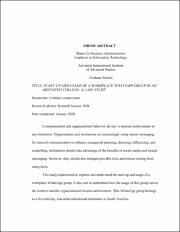Start-up and usage of workplace Whatsapp group in an Adventist college : a case study
Abstract
Communication and organizational behavior are key to mission achievement in
any institution. Organizations and institutions are increasingly using instant messaging
for internal communication to enhance managerial planning, directing, influencing, and
controlling. Institutions should take advantage of the benefits of social media and instant
messaging. However, they should also mitigate possible risks and misuse arising from
using them.
This study endeavored to explore and understand the start-up and usage of a
workplace WhatsApp group. It also aim to understand how the usage of this group serves
the workers and the organizational mission achievement. This WhatsApp group belongs
to a Seventh-day Adventist educational institution in South America.
This study followed a qualitative holistic single-case study design. For data
collection, I used video call interviews, memoing, documents, and literature review.
Participants were purposively selected. They were six members of the WhatsApp group
that fit the selection criteria and were interviewed.
A model was depicted from this case study to support an effective internal
communication system. It has four components: (a) a home workplace WhatsApp group,
(b) satellite WhatsApp groups, (c) the information flow, and (d) the users and
institutional’ belief system. It resulted in a supportive and collaborative group with a
positive organizational climate. Furthermore, the usage of this online workspace offered a
strong positive network for the employees and was an active vehicle for spiritual support.
The workplace WhatsApp group resulted in a chain reaction creating other satellite
workplace WhatsApp groups. These groups greatly contributed to the main WhatsApp
group and the effectiveness of the internal communication system. The satellites
WhatsApp groups were focused on sharing specific work-related information within each
department. On the other hand, the home WhatsApp group remained more of a cohesive
space to inform and be informed and updated. All of these created a sense of
togetherness, social bonding, technical support and work-related communication for
mission achievement. Conclusions, based on the findings depicted in the model, a home
WhatsApp group interacting with departmental satellites groups that can (a) be used as an
internal communication channel, (b) generate a strong positive network between
employees, and (c) most of all support the mission achievement in an educational
Seventh-day Adventist institution.


